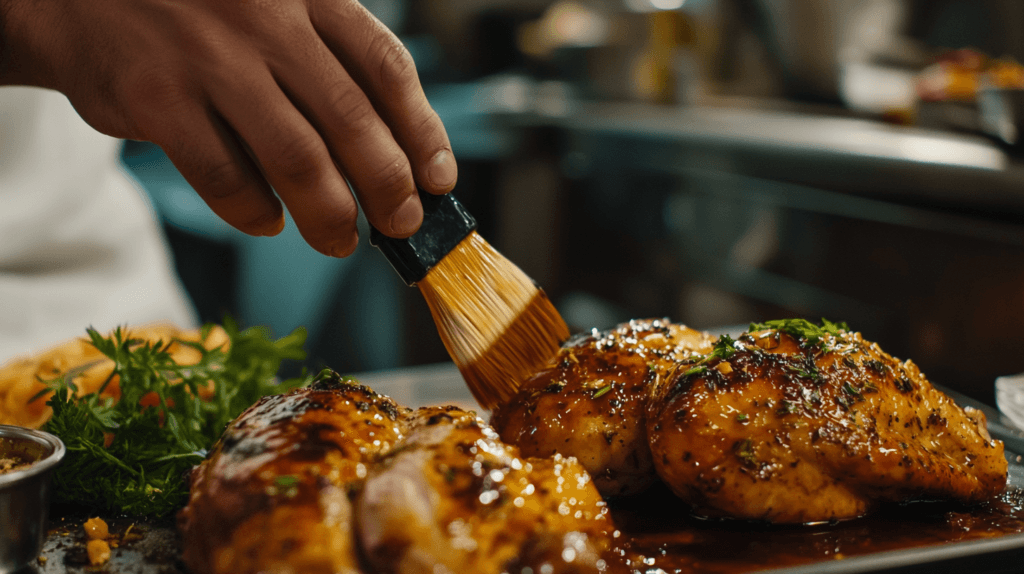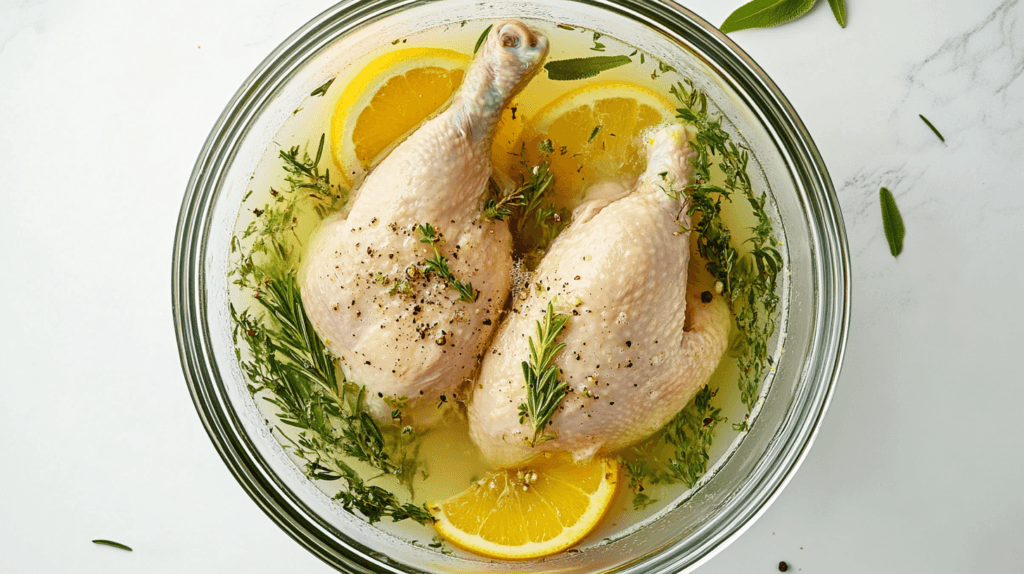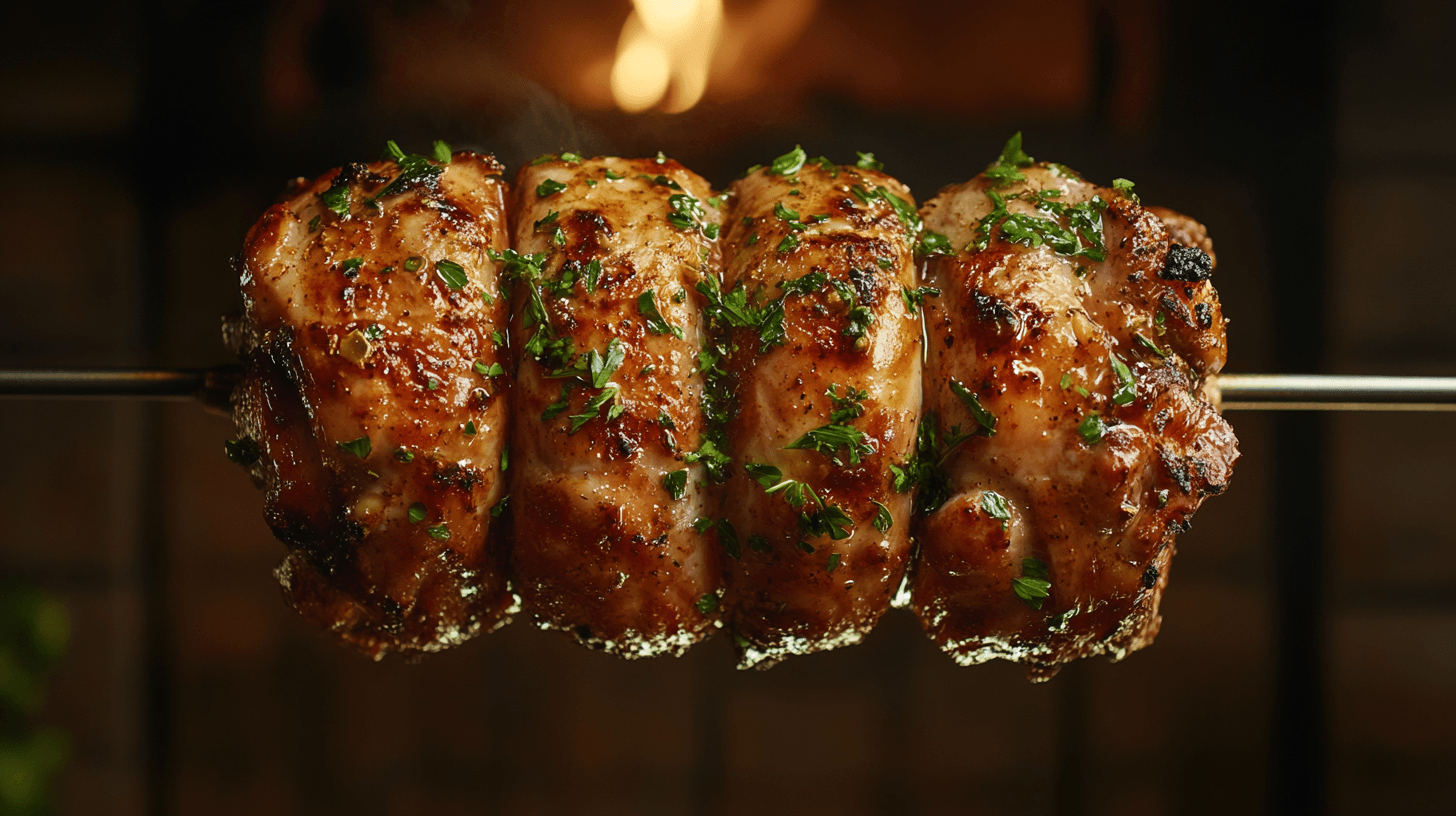Rotisserie chicken – the succulent, golden-brown delight found in grocery stores and restaurants worldwide – has an almost universal appeal. The aroma alone can make your mouth water, and its perfectly roasted exterior with tender, juicy meat inside is hard to resist. But what makes rotisserie chicken so incredibly flavorful and addictive? Is it merely the slow roasting, or is there a hidden secret that enhances its taste? Let’s unravel the mystery of this culinary marvel and discover the secret ingredient behind its widespread appeal.
Understanding Rotisserie Chicken
Rotisserie chicken has become a beloved staple in households worldwide, thanks to its rich flavor, convenience, and versatility. To fully appreciate its widespread appeal, let’s explore its history, its unique characteristics compared to other chicken preparations, and the typical process that transforms it into the golden, savory delight we all love.

The History and Popularity of Rotisserie Chicken
The art of cooking meat on a spit dates back centuries, with early methods involving a manual turning device over an open flame. Rotisserie cooking gained significant traction in medieval Europe, where it was a common sight at large feasts. Skilled cooks, often called “spit boys,” would rotate the meat by hand to ensure even cooking.
Modern rotisserie chicken became popular in the mid-20th century with the invention of mechanical rotisserie machines. These machines made it easier to cook large quantities of chicken consistently. By the late 20th century, it became a household favorite for its flavor, affordability, and convenience.
Rotisserie chicken’s popularity has soared, with retailers like Costco and Walmart offering signature versions. Its appeal lies in its taste and versatility—it works as a standalone meal or in dishes like salads and casseroles.
What Makes Rotisserie Chicken Unique?
Rotisserie chicken stands out from other chicken preparations for several reasons:
- Even Cooking: The rotisserie method ensures the chicken is evenly cooked as it rotates slowly over heat. This technique prevents overcooking or undercooking any part of the bird, resulting in tender, juicy meat throughout.
- Self-Basting Process: As the chicken rotates, its natural juices and fat drip down and continuously baste the meat. This self-basting process enhances the flavor and ensures the meat remains moist.
- Crispy, Flavorful Skin: The slow rotation and direct heat exposure create a crispy, golden-brown skin that is often seasoned to perfection. This exterior texture is a hallmark of rotisserie chicken, providing a delightful contrast to the tender interior.
- Consistent Quality: Rotisserie cooking allows for consistent results, making it a reliable choice for busy households. Whether purchased from a store or cooked at home, the method ensures a uniformly delicious product.
The Typical Cooking Process for Rotisserie Chicken
The preparation and cooking of rotisserie chicken involve several key steps that contribute to its unique flavor and texture:
- Preparation and Seasoning: Clean and prep the chicken, then brine or marinate it to infuse flavor. Generously apply a dry rub or seasoning mix to ensure the flavors permeate both the skin and the meat.
- Trussing involves tying the chicken’s wings and legs to ensure even cooking and prevent the limbs from drying out.
- Mounting on the Rotisserie Spit: Skewer the chicken onto a rotisserie spit, a long rod that securely holds it in place as it rotates.
This step is crucial for even heat distribution. - Cooking Process: The rotisserie spit rotates the chicken slowly over a heat source, typically gas or electric burners, or occasionally an open flame. The rotation ensures that the heat is evenly distributed, creating the characteristic crispy skin and tender meat. If you plan to reheat your chicken, make sure to follow the best practices shared in this article on reheating rotisserie chicken.
- Finishing Touches: Some chefs add a final glaze or additional seasoning toward the end of cooking, enhancing the flavor and creating an appetizing sheen.
By understanding the history, unique qualities, and precise cooking process of rotisserie chicken, it’s easy to see why this preparation method has captured hearts (and stomachs) around the world. Its combination of convenience, flavor, and culinary artistry ensures its place as a timeless favorite.
The Role of Seasoning in Rotisserie Chicken
Seasoning is the heart and soul of rotisserie chicken, transforming a simple roasted bird into a flavorful masterpiece. From classic herbs and spices to creative regional blends, the seasoning defines the character and appeal of rotisserie chicken. Let’s dive into the common ingredients that give rotisserie chicken its signature taste and explore how seasoning varies across different regions of the world.

Common Herbs and Spices Used in Rotisserie Chicken Recipes
A well-seasoned rotisserie chicken typically features a blend of aromatic spices, savory herbs, and a touch of sweetness or heat. Here are the most common ingredients used in seasoning:
- Salt and Pepper: The foundation of any good seasoning mix, salt enhances flavor, while black pepper adds a subtle kick.
- Garlic and Onion Powder: These versatile ingredients provide depth and a savory aroma that permeates the meat.
- Paprika: Paprika not only imparts a mild, smoky flavor but also contributes to the chicken’s appetizing golden-red color.
- Thyme and Rosemary: These herbs add earthy and slightly citrusy notes, complementing the chicken’s natural flavor.
- Parsley and Oregano: Often used for their fresh, herbaceous qualities, parsley and oregano are common in Mediterranean-inspired seasoning blends.
- Cumin and Coriander: These spices are used to add warmth and a hint of earthiness, especially in Middle Eastern or Indian-inspired recipes.
- Brown Sugar or Honey: A touch of sweetness balances the savory elements and helps create a caramelized crust.
- Chili Powder or Cayenne Pepper: For those who enjoy a spicy kick, these ingredients add heat and boldness to the flavor profile.
- Lemon or Citrus Zest: Bright, tangy notes from lemon or lime zest can elevate the overall flavor and complement the richness of the chicken.
Regional Variations in Seasoning Blends
Rotisserie chicken seasoning varies significantly across regions, reflecting local tastes, culinary traditions, and available ingredients. Here are a few notable examples:
North America
- Classic American Style: A mix of garlic, onion, paprika, thyme, and black pepper is common, creating a balanced and familiar flavor. Some variations include a hint of smoked paprika or barbecue-inspired blends.
- Cajun Style: Popular in the southern U.S., this seasoning includes bold spices like cayenne pepper, paprika, garlic powder, and dried herbs for a spicy, robust flavor.
Latin America
- Peruvian Pollo a la Brasa: A hallmark of Peruvian cuisine, this rotisserie chicken features a marinade of garlic, cumin, paprika, black pepper, soy sauce, and sometimes a splash of vinegar, creating a tangy and savory profile.
- Mexican Style: Seasoning often includes chili powder, cumin, coriander, and oregano, with lime juice adding a refreshing tang.
Mediterranean and Middle Eastern
- Mediterranean Rotisserie Chicken: Often seasoned with olive oil, lemon, oregano, rosemary, and garlic, reflecting the simple, aromatic flavors of the region.
- Middle Eastern Style: Blends like za’atar (a mix of thyme, sesame seeds, and sumac) or baharat (a warm, aromatic spice blend) are used, often combined with yogurt for marination.
Asian Variations
- Chinese Style: Soy sauce, five-spice powder, ginger, and garlic are common, creating a savory and slightly sweet flavor.
- Indian Tandoori Style: Rotisserie chicken in this style may feature a marinade of yogurt, turmeric, cumin, coriander, and garam masala, offering a bold and vibrant taste.
European Flavors
- French Herbs de Provence: A mix of dried lavender, rosemary, thyme, and fennel seeds gives a delicate, floral flavor.
- Italian Style: Basil, oregano, parsley, and garlic powder are common, often paired with olive oil and lemon zest.
The seasoning in rotisserie chicken is not merely an enhancement; rather, it is a defining element of its culinary identity. For instance, the bold spices of Cajun blends and the aromatic herbs of Mediterranean recipes bring life and diversity to this beloved dish. Consequently, seasoning makes rotisserie chicken a favorite across cultures and palates.
Exploring the Secret Ingredient
Rotisserie chicken captivates taste buds like few other dishes, and as a result, many wonder about the secret ingredient behind its irresistibility. While its preparation involves various techniques and seasonings, a specific component or process often elevates its flavor, texture, and moisture to near perfection. Therefore, let’s explore the possibilities of this “secret ingredient,” delve into the science behind its impact on taste, and uncover how it enhances the overall rotisserie chicken experience.
What Is the Secret Ingredient in Rotisserie Chicken?
The “secret ingredient” in rotisserie chicken can vary depending on the recipe, but it typically falls into one of these categories:
- Brine Solutions: Many rotisserie chickens are soaked in a brine made of water, salt, sugar, and sometimes herbs and spices. This process ensures the meat stays juicy and well-seasoned.
- Flavor Enhancers: Commercial rotisserie chickens often use flavor-enhancing solutions, such as chicken broth, sodium phosphates, or monosodium glutamate (MSG), to intensify the savory taste.
- Fat Basting: Some recipes rely on butter or rendered chicken fat to keep the meat moist and enrich the flavor as it cooks.
- Unique Seasoning Blends: A signature mix of spices and herbs, including unexpected additions like smoked paprika, turmeric, or citrus zest, might be the “secret” touch that distinguishes one rotisserie chicken from another.
- Umami Boosters: Ingredients like soy sauce, Worcestershire sauce, or anchovy paste may be added to create a rich, umami-packed flavor profile.
- Low-and-Slow Roasting: While not an ingredient in the traditional sense, the method of slow, even cooking allows flavors to develop deeply and enhances the chicken’s natural taste.
The Science Behind the Secret Ingredient’s Impact on Taste
The science behind these secret techniques and ingredients is rooted in their ability to interact with the chicken’s proteins, fats, and natural juices. Here’s how they work:
- Brining
- Hydration: Salt in the brine breaks down muscle proteins, allowing the meat to absorb water. This process keeps the chicken juicy even after hours of cooking.
- Flavor Infusion: Salt and spices penetrate the meat, seasoning it deeply rather than just on the surface.
- Umami and Flavor Enhancers
- Savory Depth: Ingredients like MSG or soy sauce enhance glutamate levels in the chicken, stimulating taste receptors and creating a deeply savory, satisfying flavor.
- Aroma Amplification: Certain spices and flavorings release volatile compounds during cooking, intensifying the aroma and overall appeal.
- Fats and Oils
- Texture Enhancement: Fat creates a silky mouthfeel and contributes to the crispy skin that is a hallmark of rotisserie chicken.
- Flavor Delivery: Fat acts as a carrier for fat-soluble flavor compounds in spices and herbs, ensuring they’re evenly distributed.
- Caramelization and Maillard Reaction
- The heat from roasting triggers the Maillard reaction, a chemical process that browns the chicken’s skin and produces complex, nutty, and roasted flavors. Sugars in marinades or rubs also caramelize, adding a subtle sweetness.
How the Secret Ingredient Enhances Flavor, Texture, and Moisture
The combination of these elements ensures rotisserie chicken is not only flavorful but also tender and satisfying:
- Flavor: The deep seasoning from brines, rubs, and marinades, coupled with umami enhancers, creates a chicken that’s savory, aromatic, and multidimensional in taste.
- Texture: The rotation during cooking, coupled with fat and the Maillard reaction, yields a crispy, golden skin that contrasts perfectly with the soft, juicy meat inside.
- Moisture: Brining, fat basting, and slow roasting work together to lock in the chicken’s natural juices. Even after reheating, rotisserie chicken retains its moisture, making it a convenient and consistent choice.
Proper storage techniques can also help retain moisture and flavor in rotisserie chicken, as detailed in this guide to rotisserie chicken storage tips.
The “secret ingredient” in rotisserie chicken combines science, technique, and culinary creativity. Balanced brines, unique seasonings, or umami touches all contribute to the flavorful, tender, and moist chicken we love. Next time you savor rotisserie chicken, you’ll taste the hidden secrets behind every delicious bite.
Marinades and Brining: A Flavor Foundation
Marinades and brining are essential techniques in preparing rotisserie chicken, providing a foundation of flavor, moisture, and tenderness that sets it apart from other methods of cooking. These processes ensure that every bite of the chicken is infused with taste and texture that delights the palate.

The Purpose of Marinades and Brining in Rotisserie Chicken
- Flavor Infusion: Marinades and brines penetrate deep into the meat, ensuring that flavor isn’t limited to the surface. This creates a well-seasoned chicken with layers of taste throughout.
- Moisture Retention: Brining introduces additional liquid into the chicken, which helps it retain moisture during the cooking process. This is especially important for slow-roasted methods like rotisserie cooking, which can risk drying out the meat without proper preparation.
- Tenderization: Acidic ingredients in marinades (such as vinegar, citrus juice, or yogurt) break down muscle fibers, resulting in a tender, juicy texture. Salt in brines alters the protein structure, allowing the chicken to hold onto more liquid and improving its overall texture.
- Enhanced Browning and Caramelization: Sugars and oils in marinades or brines promote browning during cooking, creating the deliciously crispy, golden skin that is characteristic of rotisserie chicken.
Key Ingredients in Brines That Contribute to the Secret Ingredient
Brines are more than just salt and water—they are an opportunity to add complexity to the chicken’s flavor. Common ingredients include:
- Salt: The primary component, essential for flavor and moisture retention.
- Sugar: Adds a touch of sweetness and aids in browning.
- Herbs and Spices: Bay leaves, thyme, rosemary, and black peppercorns are frequently used to enhance flavor.
- Aromatics: Garlic, onions, and citrus zest infuse the chicken with subtle but impactful notes.
- Liquid Base: Water is the most common base, but some recipes use broth, apple cider, or wine for added depth.
The Role of Aromatics
Aromatics such as garlic, onions, and herbs are fundamental to the flavor profile of rotisserie chicken. These ingredients release volatile compounds during cooking, creating a mouthwatering aroma and enriching the overall taste.
Garlic, Onions, and Other Aromatics as Potential Secret Ingredients
- Garlic: Garlic’s natural compounds, such as allicin, provide a savory depth and a slightly sweet, nutty flavor when roasted. Whether minced, sliced, or whole, garlic is a cornerstone ingredient in many rotisserie chicken recipes.
- Onions: Onions bring a sweet, caramelized flavor to the table. Their high sugar content makes them ideal for slow roasting, where they soften and meld into the chicken’s juices.
- Citrus: Lemon, lime, or orange zest adds brightness and a touch of acidity that balances the richness of the chicken.
- Fresh Herbs: Aromatics like rosemary, thyme, and sage provide earthy, floral, and piney notes that complement the savory profile of the chicken.
- Other Vegetables: Celery, carrots, and fennel are occasionally added to enhance the base flavor of the chicken and its drippings.
Techniques for Infusing Aromatics During Cooking
- Stuffing the Cavity: Placing whole garlic cloves, onion halves, and sprigs of fresh herbs inside the chicken cavity allows their flavors to infuse the meat as it cooks. This is a simple yet effective way to enhance flavor.
- Marinades and Rubs: Blend aromatics into marinades or rubs to allow their essence to penetrate the meat before cooking.
- Garlic- or herb-infused oils or butters can be applied to the chicken’s surface or under the skin. This intensifies flavor and promotes browning.
- Wood chips infused with herbs or spices can add a smoky, aromatic twist during the cooking process.
- Placing aromatics in the drip tray lets their flavors mix with the juices. These can be basted onto the chicken or used for a flavorful sauce.
By incorporating marinades, brines, and aromatics, rotisserie chicken achieves its signature depth of flavor, mouthwatering aroma, and juicy texture. These methods and ingredients transform a simple roasted chicken into a culinary masterpiece that resonates with comfort and indulgence.
FAQs on Rotisserie Chicken
Rotisserie chicken is a popular dish, but its preparation and appeal often spark curiosity. Here are six frequently asked questions about rotisserie chicken and their answers:
1. What makes rotisserie chicken so flavorful?
The flavor of rotisserie chicken comes from a combination of factors: brining or marinating to season the meat deeply, the use of aromatic herbs and spices, and the slow, even cooking process that locks in moisture and enhances taste.
2. Is rotisserie chicken healthy?
Yes, rotisserie chicken can be a healthy choice, especially when compared to fried options. It’s high in protein, relatively low in fat (especially if you remove the skin), and versatile enough to pair with vegetables, salads, or whole grains.
3. How do you keep rotisserie chicken moist?
The key to keeping rotisserie chicken moist lies in preparation. Brining before cooking hydrates the meat, while the self-basting effect of rotating ensures even cooking. Adding fat, such as butter or oil, and cooking at a consistent, moderate temperature also helps retain moisture.
4. What are some creative uses for leftover rotisserie chicken?
Leftover rotisserie chicken can be used in salads, sandwiches, soups, casseroles, tacos, or even pasta dishes. It’s an excellent ingredient for quick, flavorful meals.
For creative ideas to use your leftovers, check out these delicious leftover rotisserie chicken recipes.
Conclusion: Cracking the Secret
Rotisserie chicken’s allure lies in the harmony of preparation techniques and seasoning artistry. From the science of brining and marinades to the aromatic magic of herbs and spices, every step contributes to its rich flavor, tender texture, and tantalizing aroma.
The “secret ingredient” isn’t just one element—it’s the interplay of careful preparation, thoughtful seasoning, and precise cooking. Whether it’s a special blend of spices, a touch of umami, or the perfect basting technique, these elements combine to create the irresistible rotisserie chicken we all love.
Inspiring Readers to Experiment
Now that you understand the secrets behind rotisserie chicken, it’s time to bring your creativity to the table. Experiment with different marinades, brines, and seasoning blends to craft your own signature recipe. Try incorporating regional flavors, or add a personal twist with unique aromatics or basting ingredients. With a bit of experimentation, you can turn your kitchen into a rotisserie paradise and create a chicken dish that’s entirely your own.
Enjoy the process—and the delicious results!

